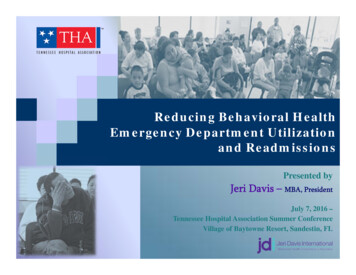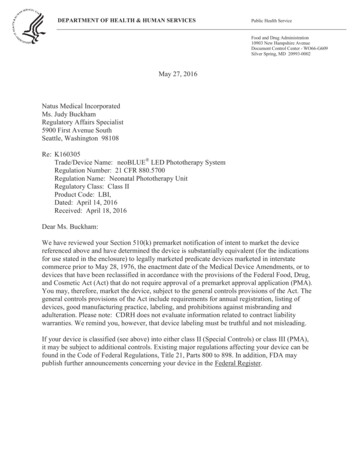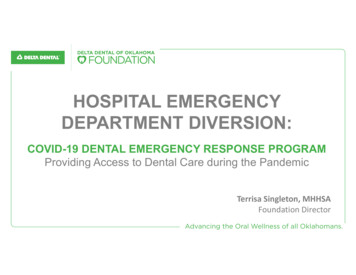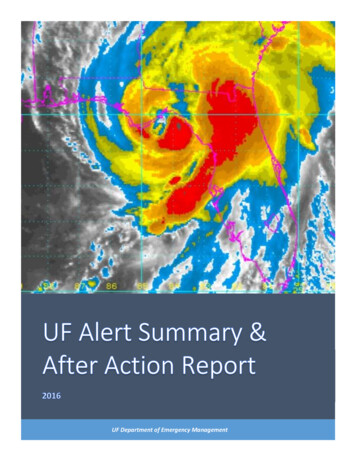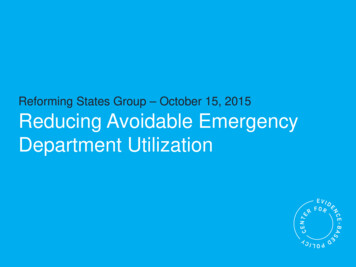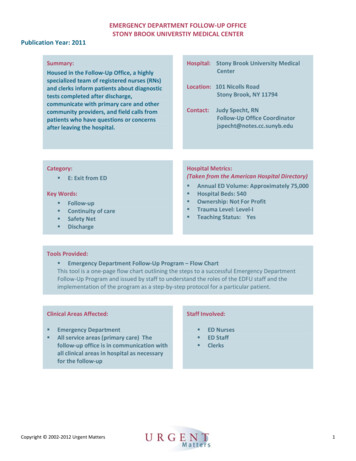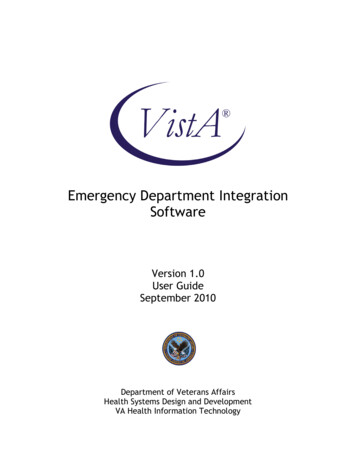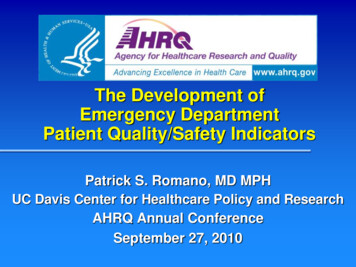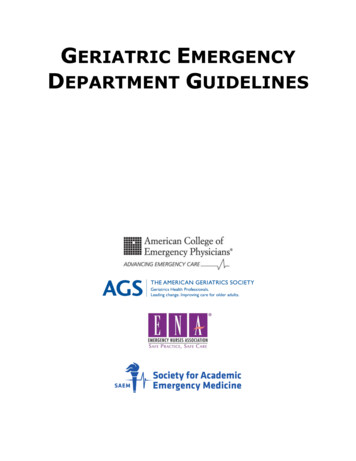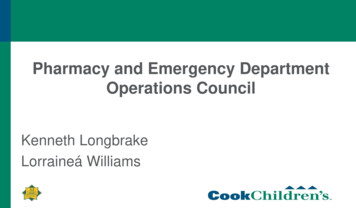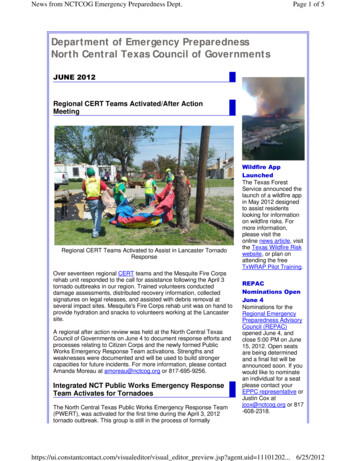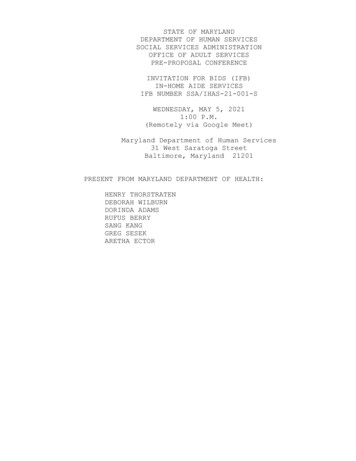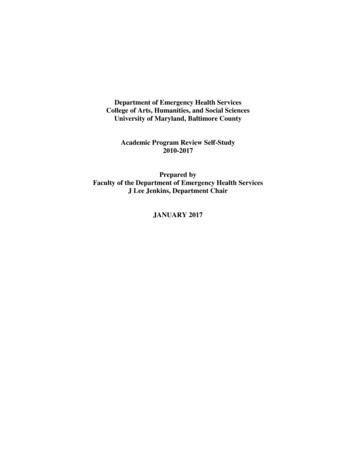
Transcription
Department of Emergency Health ServicesCollege of Arts, Humanities, and Social SciencesUniversity of Maryland, Baltimore CountyAcademic Program Review Self-Study2010-2017Prepared byFaculty of the Department of Emergency Health ServicesJ Lee Jenkins, Department ChairJANUARY 2017
Table of ContentsEXECUTIVE SUMMARY . 5DESCRIPTION OF THE PROGRAM . 10HISTORY OF THE PROGRAM. 10MISSION . 11RELATIONSHIP TO UMBC MISSION . 12ORGANIZATION AND SPECIALIZATIONS . 13ADMINISTRATIVE STRUCTURE AND OPERATIVE COMMITTEES . 15DEGREES OFFERED . 15EDUCATIONAL GOALS, LEARNING OUTCOMES, ANDPROGRAM ASSESSMENT PLAN . 16Undergraduate Program Assessment . 17Graduate Program Assessment. 21EHS Courses with General Education Designation . 23CURRICULUM . 25Undergraduate Management Curriculum . 25Emergency Health Services Minor Curriculum . 27Graduate Program Curriculum . 28Emergency Services Concentration, Public Policy Doctoral Degree . 31Emergency Health Pathway, EHS Curriculum. 31Emergency Management Pathway, EHS Curriculum. 31FACULTY PROFILE . 32FACULTY RESEARCH & SCHOLARLY ACTIVITY . 35Faculty Research and Scholarly Activity . 35Books . 35Grants, Funding . 36Publications . 36RESEARCH INFRASTRUCTURE PLANNING . 38Emergency Health Services Research Areas of Excellence . 38Infrastructure Planning . 38TEACHING QUALITY . 402
SERVICE . 41Service to the University . 41Service to the Public . 41Service to the Profession . 42STUDENT PROFILE . 42Undergraduate Enrollment and Degrees. 42Graduate Enrollment and Degrees . 43STUDENT ADVISING . 44Undergraduate Student Advising . 44Graduate Student Advising . 44FINANCIAL SUPPORT FOR GRADUATE STUDENTS . 45STUDENT RESEARCH . 46Undergraduate Student Research . 46Graduate Student Research . 46FACILITIES . 48Administrative Space . 48Room 318 . 48Room 303 . 49Graduate student space. 49Laboratories. 49Equipment . 49Pending Space Request . 49CLIMATE . 50Recent Faculty Climate . 50Student Climate . 51Department Transition . 52PROFILE OF GRADUATES . 52Undergraduate Program Graduates. 52Graduate Alumni Profile. 53BUDGET . 543
EVALUATION. 55Strengths . 55Weaknesses . 56Opportunities . 57Threats . 58FUTURE DIRECTIONS . 59Appendix A: Organizational Structure . 62Appendix B: Undergraduate Management Track Alumni Placement 2012-2016 . 63Appendix C: Graduate Program Alumni Placement Survey Results January 2017 . 64Appendix D: . 65Appendix E: . 72Graduate and Undergraduate Student Research Projects . 72Graduate Student presentations, papers, articles, books, etc. . 72Reviews or Editorials in Refereed Journals: Nable . 74Books or Chapters in Books: Nable . 75Other Publications : Nable . 75Abstracts for Conference papers and posters: Nable . 76Invited Lectures: Nable . 76Invited Lectures: Other . 794
EXECUTIVE SUMMARYThe Department of Emergency Health Services (EHS) is an academic department within theCollege of Arts, Humanities, and Social Sciences (CAHSS). The EHS program was formed atUMBC by one of the early visionaries in EMS, Dr. R Adams Cowley of University Hospital,University of Maryland, and many of our alumni excel in strong state and national leadershiproles in EMS, public health and disaster.Mission and Relationship to UMBCThe EHS Department strives to combine teaching, research, and service within a dynamicframework of educational excellence and scholarly leadership. It is the vision of the departmentto be "the international leader in emergency health services’ education". This is accomplishedthrough the "integration of research, teaching and learning and civic engagement." Research bythe department’s faculty addresses issues in disaster medicine, emergency public health, mobileintegrated health, and clinical simulation.Organization and SpecialtiesThe EHS Department offers a Bachelor’s of Science in Emergency Health in either aManagement Track or a Paramedic Track. The Management Track is designed to meet the needsof students who plan to focus their career on the development and management of emergencyhealth care systems at the local, state, and federal levels. Paramedic Track also enrolleescomplete a vigorous regimen of science. The Emergency Management Post-BaccalaureateCertificate is a 5-course stand-alone option.The graduate program in EHS offers a Master’s of Science in Emergency Health Services withthree tracks: Administration, Planning and Policy; Preventive Medicine and Epidemiology; andEducation. An Emergency Management concentration can be merged with any of the existingtracks or can be taken alone as a post-graduate certificate program.The Emergency Services Concentration within the Public Policy, PhD has two pathways:health and management. The emergency health pathway includes courses in disaster health,catastrophes, and systems design. The emergency management pathway includes courses indisaster mitigation, catastrophe preparation and response, and strategic planning.The department also administers a Professional and Continuing Education (PACE) programfor prehospital and hospital allied health providers with the intent of providing additional fundsto for education and research. The program provides nationally recognized curricula such asCritical Care Paramedic (CCEMT-P) and Paramedic Refresher.Educational Goals, Learning Outcomes, and Program Assessment PlanThe EHS Department regularly assesses the learning outcomes of its majors and alumnithrough the CAHSS Student Assessment Plan in addition to supplementary techniques. Theassessment of the Undergraduate Paramedic Track is through the Committee on Accreditation ofEducational Programs for the Emergency Medical Services Professions (CoAEMSP). Appliedskills and knowledge assessment of the Management Track occurs through the internship and theSenior Capstone Project. Students in the Graduate Master’s Program complete either a5
comprehensive examination, thesis, or capstone project as their final assessment. Assessment ofdoctoral students in the Graduate Program will be completed through a Field Examination and aDoctoral Dissertation Defense.The Program Assessment in the APR Self Study describes how the department and programStudent Learning Objectives align strategically with UMBC’s Functional Competencies. TheEducational Goals and Learning Outcomes are reflected within the EHS Department’s StudentLearning Objectives and include the ability to apply competency within the major, demonstrateoral and written communications, and be prepared for graduate and professional degreeprograms. Assessment of the graduate program’s educational goals and learning outcomes hasfound that students are meeting their applied competency skills well through internships andGRA positions. The EHS Department carries three courses with General Education Designationincluding EHS 200 Concepts of Emergency Health Services, EHS 311 Stress and Burnout:Personal and Professional Issues, and EHS 345 Death and Dying, which all meet the competencyrequirement for information literacy for a General Education Course Competency in the SocialScience category.Curriculum and State of the ArtThe undergraduate Management Track Curriculum includes courses in EMS history, EMTBasic, EMS systems planning, management, stress, disaster, and a senior internship. Manystudents also choose a minor in Public Administration. The graduate program, available onlineand on-campus, has three curricula for the Administration, Planning and Policy Track, theEpidemiology and Preventive Medicine Track, and the Education Track. The Epidemiology andPreventive Medicine Track and the Education Track are offered jointly with the UM’s School ofMedicine and the UMBC Department of Education. Doctoral students take a combination ofEHS graduate health or management classes and School of Public Policy classes.Faculty ProfileOur department is currently in a marked state of change. We have a new chair, and the majorityof our very small faculty are retiring in the next five years. In the past two years, the departmenthas also taken on the responsibility of funding a portion or entirety of two faculty members’salaries. The department expects a potential for two tenure track retirements, two non-tenuredretirements and one non-tenured track transition in the next five years. This constitutes almostthe entirety of our faculty with the exception of one lecturer and the current Chair.Faculty Research and Scholarly ActivityAll EHS faculty members, tenured and non-tenured have an active research and publicationagenda. This research is almost all multi-disciplinary in content, containing material, concepts,paradigms, and methods from medicine, public health, mental health, sociology, economics,policy sciences, emergency management, organizational planning and management, and history.Recent projects have been funded by the Maryland Department of Health and Human Servicesand the Centers for Disease Control and Prevention.Emergency Health Services Research Areas of ExcellenceAfter thorough review of the current major themes in EMS and Emergency Public Healtheducation, the department has identified three current areas of excellence that correspond to6
current faculty interest and skills. These include Mobile Integrated Health, Clinical Simulationand Education, and Emergency Public Health and Disasters.Infrastructure PlanningThe department is currently in need of increased administrative and faculty resources to supportthe new joint PhD program and research initiatives in disaster health and mobile integratedhealth. A multi-year growth initiative has begun with the planning of the new ClinicalSimulation Laboratory for innovative pedagogy in health research. After completion ofconstruction of the proposed space (in the Sherman Hall 2nd floor), the department plans toconstruct a modern healthcare simulation space. Currently the department has two pending jointresearch grants in simulation from the National Science Foundation with the UMBC Departmentof Information Systems. This work is both multi-disciplinary and spans two colleges in scopeand practice.Teaching Quality and Faculty MentoringIt is the priority of all faculty and a mission of the department of EHS to provide excellence andinnovation in EMS and emergency public health education. Our faculty are known for theirdedication to students, teaching, and advising. Balancing faculty time with demands on teaching,research, grant application, and administration is a challenge given the current 3 2 course loadfor tenure track faculty. Total credit hours generated in FY12 were 2832 compared to last yearFY16 of 2970. We would like to note that the majority of our faculty are teaching in overloaddespite the increased level of utilization of adjunct faculty for teaching.ServiceService to the department, university and community is a hallmark of EHS. All faculty membersparticipate in committee assignments at the department and University level. A majority offaculty in the department continue to serve the medical community in either a volunteer or paidcapacity. Of our faculty members, four are licensed paramedics and another is an aviation/flightparamedic. Two faculty are mental health professionals who provide volunteer service onCritical Incident Stress Management Teams. Dr. Jenkins is an Emergency Physician andsupervises our own paramedic students in clinicals.Student ProfileEnrollment in the undergraduate EHS program has ranged from 92 (2013) to 112 (2011) with afive year average of 101 students. Part-time undergraduates continue to constitute approximately10% of students over the past five years. These are most often Management Track students whoare more likely to work full-time while attending school. Undergraduates also tend to be in-statestudents (66%), male (70%), and white (65%). Enrollment in the Graduate Program has beenconsistent over the past five years at approximately 30 students.Student AdvisingUndergraduate advisement is conducted by Dwight Polk for the paramedic track students andDiane Flint for the management track students. Mr. Polk and Ms. Flint make themselvesavailable for extended office hours for three weeks as soon as the registration system is madeavailable for class registrations. Therefore, there is advisement conducted in the fall and spring7
semesters. The graduate program of the Department of Emergency Health Services has only twofaculty whose primary responsibility is to graduate students (Bissell
UMBC by one of the early visionaries in EMS, Dr. R Adams Cowley of University Hospital, . Educational Programs for the Emergency Medical Services Professions (CoAEMSP). Applied . the new joint PhD program and rese
